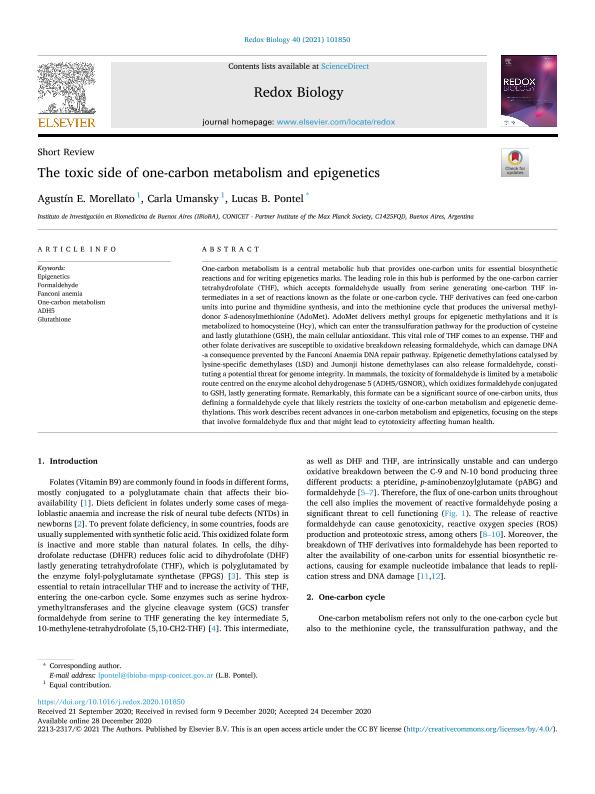Mostrar el registro sencillo del ítem
dc.contributor.author
Morellato, Agustín Ezequiel

dc.contributor.author
Umansky, Carla

dc.contributor.author
Pontel, Lucas Blas

dc.date.available
2023-01-12T18:27:44Z
dc.date.issued
2021-04
dc.identifier.citation
Morellato, Agustín Ezequiel; Umansky, Carla; Pontel, Lucas Blas; The toxic side of one-carbon metabolism and epigenetics; Elsevier; Redox Biology; 40; 4-2021; 1-7
dc.identifier.issn
2213-2317
dc.identifier.uri
http://hdl.handle.net/11336/184596
dc.description.abstract
One-carbon metabolism is a central metabolic hub that provides one-carbon units for essential biosynthetic reactions and for writing epigenetics marks. The leading role in this hub is performed by the one-carbon carrier tetrahydrofolate (THF), which accepts formaldehyde usually from serine generating one-carbon THF intermediates in a set of reactions known as the folate or one-carbon cycle. THF derivatives can feed one-carbon units into purine and thymidine synthesis, and into the methionine cycle that produces the universal methyl-donor S-adenosylmethionine (AdoMet). AdoMet delivers methyl groups for epigenetic methylations and it is metabolized to homocysteine (Hcy), which can enter the transsulfuration pathway for the production of cysteine and lastly glutathione (GSH), the main cellular antioxidant. This vital role of THF comes to an expense. THF and other folate derivatives are susceptible to oxidative breakdown releasing formaldehyde, which can damage DNA -a consequence prevented by the Fanconi Anaemia DNA repair pathway. Epigenetic demethylations catalysed by lysine-specific demethylases (LSD) and Jumonji histone demethylases can also release formaldehyde, constituting a potential threat for genome integrity. In mammals, the toxicity of formaldehyde is limited by a metabolic route centred on the enzyme alcohol dehydrogenase 5 (ADH5/GSNOR), which oxidizes formaldehyde conjugated to GSH, lastly generating formate. Remarkably, this formate can be a significant source of one-carbon units, thus defining a formaldehyde cycle that likely restricts the toxicity of one-carbon metabolism and epigenetic demethylations. This work describes recent advances in one-carbon metabolism and epigenetics, focusing on the steps that involve formaldehyde flux and that might lead to cytotoxicity affecting human health.
dc.format
application/pdf
dc.language.iso
eng
dc.publisher
Elsevier

dc.rights
info:eu-repo/semantics/openAccess
dc.rights.uri
https://creativecommons.org/licenses/by/2.5/ar/
dc.subject
ADH5
dc.subject
EPIGENETICS
dc.subject
FANCONI ANEMIA
dc.subject
FORMALDEHYDE
dc.subject
GLUTATHIONE
dc.subject
ONE-CARBON METABOLISM
dc.subject.classification
Biología Celular, Microbiología

dc.subject.classification
Ciencias Biológicas

dc.subject.classification
CIENCIAS NATURALES Y EXACTAS

dc.title
The toxic side of one-carbon metabolism and epigenetics
dc.type
info:eu-repo/semantics/article
dc.type
info:ar-repo/semantics/artículo
dc.type
info:eu-repo/semantics/publishedVersion
dc.date.updated
2022-10-04T10:51:59Z
dc.journal.volume
40
dc.journal.pagination
1-7
dc.journal.pais
Países Bajos

dc.journal.ciudad
Amsterdam
dc.description.fil
Fil: Morellato, Agustín Ezequiel. Consejo Nacional de Investigaciones Científicas y Técnicas. Oficina de Coordinación Administrativa Parque Centenario. Instituto de Investigación en Biomedicina de Buenos Aires - Instituto Partner de la Sociedad Max Planck; Argentina
dc.description.fil
Fil: Umansky, Carla. Consejo Nacional de Investigaciones Científicas y Técnicas. Oficina de Coordinación Administrativa Parque Centenario. Instituto de Investigación en Biomedicina de Buenos Aires - Instituto Partner de la Sociedad Max Planck; Argentina
dc.description.fil
Fil: Pontel, Lucas Blas. Consejo Nacional de Investigaciones Científicas y Técnicas. Oficina de Coordinación Administrativa Parque Centenario. Instituto de Investigación en Biomedicina de Buenos Aires - Instituto Partner de la Sociedad Max Planck; Argentina
dc.journal.title
Redox Biology
dc.relation.alternativeid
info:eu-repo/semantics/altIdentifier/url/https://www.sciencedirect.com/science/article/pii/S2213231720310557
dc.relation.alternativeid
info:eu-repo/semantics/altIdentifier/doi/http://dx.doi.org/10.1016/j.redox.2020.101850
Archivos asociados
